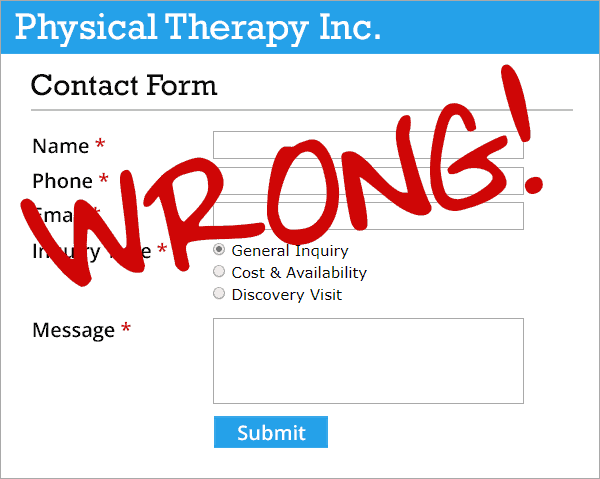I’ve been carrying out free website audits, checking the potential to generate leads for members of Paul Gough’s Cash Club and 4% Club for several years now and I’m sure it won’t surprise you to know that I see the same problems on many of the websites I look at. So in this article I’m going to discuss the top 5 most common ways that physical therapy websites are losing leads.
Whether you are using Google ads, Facebook ads, SEO, newspaper ads or any other means of getting people to visit your website, you are making an investment (if not financial then you’re investing your time) and if you could increase the percentage of visitors who become leads then you’re going to see an increase in your ROI. Put another way, if you can plug the holes in your website where the leads are leaking out you’re going to get more leads!
So, what is a lead? Let’s be clear about this first – a lead is NOT simply a website visitor. A lead has reached out to you either by requesting a free guide or by filling out an inquiry form and by doing so they have provided you with their contact information. They have enabled you to start the process of nurturing them towards becoming a prospect and ultimately a paying patient. Website leads begin life as website visitors. If you do your job right (or rather if your website does its job right) then a percentage of your website visitors will become leads. So let’s look at the 5 ways your website could be letting you down and losing leads…
#1 Lack of Trust
In order for a visitor to take the next step and engage with you there has to be trust. If your website doesn’t position you as trustworthy it’s unlikely people will want to reach out to you. If your website is missing any of the following features then it’s not doing enough to build trust:
- Intro video – your home page must include a video and it needs to be of the business owner / the “face” of the business. That person needs to talk directly to the camera as if talking to the website visitor. No fancy animated intro and no need for slick editing. There’s nothing better than one human being talking to another human being for creating trust.
- Free guides to create the perception of expertise and authority – even if you don’t get many people opting in for these guides (eBooks) the fact that you have them on display will influence your visitors and helps them perceive you as a credible authority on their specific problem.
- Social proof – you need to let visitors see that you’ve helped (and been trusted by) people just like them. People of their age group, from their town who had a similar problem and are now happy that their problem is fixed thanks to you! Pulling in Google reviews is OK but video testimonials are the best.
#2 Insufficient Calls to Action
Never be afraid to tell people what action you want them to take! Think of it rather as giving them permission to take action. You can remove uncertainty about what your visitors should do simply by placing clear call-to-action buttons strategically within your website content. Example: Inquire About Cost & Availability – Click Here ». EVERY page of your website should have at least one call-to-action button. The main goal is to get people to fill out an inquiry form so you should be inviting them (telling them) to do that at every opportunity. Don’t be shy about it – remember that you just want to help them and in order to do that you need them to reach out to you.
#3 Generic Contact Form
I’ve written about this many times before but I still see websites that are losing leads because they use one webform for all types of inquiries. It doesn’t matter if you include an option for people to select what type of inquiry they want to make – this is NOT acceptable! If you have managed to get a visitor to trust you enough to reach out to you and you present them with a generic contact form you will lose 99% of them and what a tragic loss! Invest time (and money if you have to) in order to create a dedicated inquiry form. Ask engaging questions that make the visitor feel like you know them and understand them already and use form fields with multiple-choice answers wherever possible so your visitors don’t have to think too long and hard about their answers.
#4 Limited Options for Engagement
An inquiry form should not be the only way that people can engage with you. Some people would prefer to send you a personal email, some will call you on the phone, others prefer live chat and some would rather use Facebook Messenger. Your visitors will all have their own reasons for their preferred means of communication and if you’re not offering all these options to your visitors then you are losing leads because of it! Warm leads (those who are ready to become prospects) will fill out an inquiry form whereas colder leads might prefer live chat or Facebook Messenger because it feels like less of a “commitment” initially. So it’s essential to offer multiple ways for visitors to reach out to you.
#5 Lack of Explanation and Encouragement
Confused visitors don’t take action. They leave and will likely go to your competitor’s website instead and you might never see them again. Your website can confuse visitors by having too much information, poor navigation and a lack of clear calls to action. Take a look at your website and try to think like someone who is new to physical therapy and is skeptical about it. Does your website clearly explain WHO you help and how people can take the next step in the journey towards receiving your help? Does it talk to people in a way that lets them know you understand them and their current fears/skepticism/objections? And does it encourage them to reach out to you? Remember what I said in #1 above – don’t be afraid to tell people what action you want them to take. Help people to understand what’s expected of them and there’s a good chance they will take the action you’re directing them towards!
Summary
Losing leads is basically losing money. Every person who visits your website could potentially be a valuable future patient. If your website is making any of the mistakes I’ve described above then it’s losing leads and it’s costing you money. Obviously we can’t convert every visitor to a lead but every lead we lose is potentially thousands of dollars in lifetime patient value lost, so it’s essential that you review your website regularly to ensure there aren’t any obvious “lead leaks”!
This article was originally published in Paul Gough’s Cash is King Newsletter in January 2020











